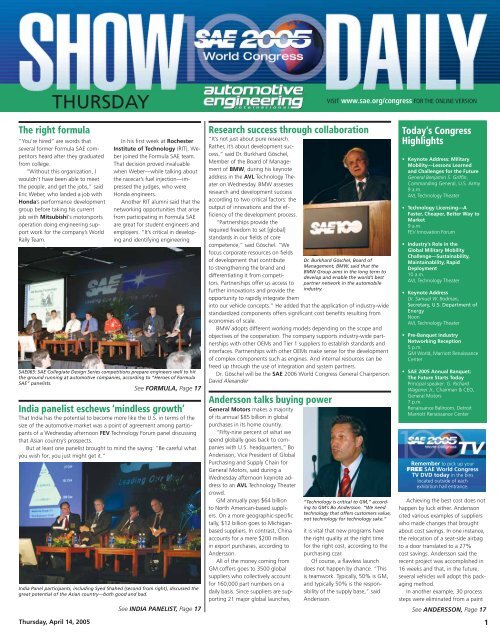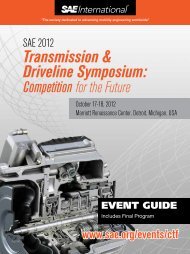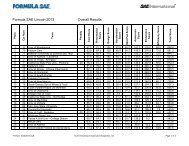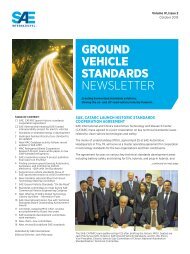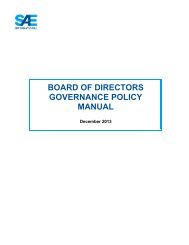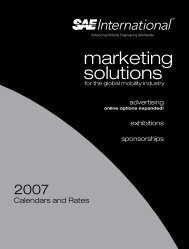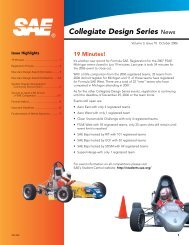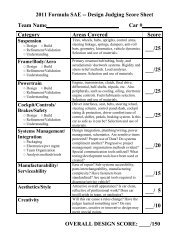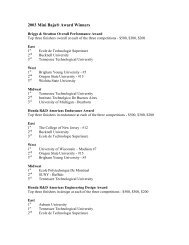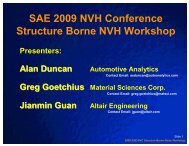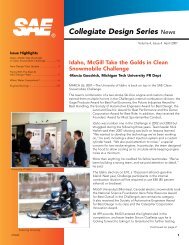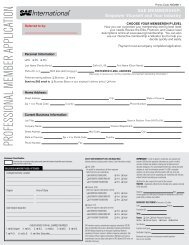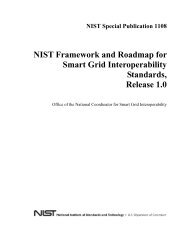THURSDAY - SAE International
THURSDAY - SAE International
THURSDAY - SAE International
Create successful ePaper yourself
Turn your PDF publications into a flip-book with our unique Google optimized e-Paper software.
<strong>THURSDAY</strong><br />
VISIT www.sae.org/congress FOR THE ONLINE VERSION<br />
The right formula<br />
”You’re hired” are words that<br />
several former Formula <strong>SAE</strong> competitors<br />
heard after they graduated<br />
from college.<br />
”Without this organization, I<br />
wouldn’t have been able to meet<br />
the people, and get the jobs,” said<br />
Eric Weber, who landed a job with<br />
Honda’s performance development<br />
group before taking his current<br />
job with Mitsubishi‘s motorsports<br />
operation doing engineering support<br />
work for the company’s World<br />
Rally Team.<br />
In his first week at Rochester<br />
Institute of Technology (RIT), Weber<br />
joined the Formula <strong>SAE</strong> team.<br />
That decision proved invaluable<br />
when Weber—while talking about<br />
the racecar’s fuel injection—impressed<br />
the judges, who were<br />
Honda engineers.<br />
Another RIT alumni said that the<br />
networking opportunities that arise<br />
from participating in Formula <strong>SAE</strong><br />
are great for student engineers and<br />
employers. “It’s critical in developing<br />
and identifying engineering<br />
<strong>SAE</strong>065: <strong>SAE</strong> Collegiate Design Series competitions prepare engineers well to hit<br />
the ground running at automotive companies, according to “Heroes of Formula<br />
<strong>SAE</strong>” panelists.<br />
See FORMULA, Page 17<br />
India panelist eschews ‘mindless growth’<br />
That India has the potential to become more like the U.S. in terms of the<br />
size of the automotive market was a point of agreement among participants<br />
of a Wednesday afternoon FEV Technology Forum panel discussing<br />
that Asian country’s prospects.<br />
But at least one panelist brought to mind the saying: ”Be careful what<br />
you wish for; you just might get it.”<br />
India Panel participants, including Syed Shahed (second from right), discussed the<br />
great potential of the Asian country—both good and bad.<br />
See INDIA PANELIST, Page 17<br />
Research success through collaboration<br />
“It’s not just about pure research.<br />
Rather, it’s about development success,”<br />
said Dr. Burkhard Göschel,<br />
Member of the Board of Management<br />
of BMW, during his keynote<br />
address in the AVL Technology Theater<br />
on Wednesday. BMW assesses<br />
research and development success<br />
according to two critical factors: the<br />
output of innovations and the efficiency<br />
of the development process.<br />
“Partnerships provide the<br />
required freedom to set [global]<br />
standards in our fields of core<br />
competence,” said Göschel. “We<br />
focus corporate resources on fields<br />
of development that contribute<br />
to strengthening the brand and<br />
differentiating it from competitors.<br />
Partnerships offer us access to<br />
further innovations and provide the<br />
opportunity to rapidly integrate them<br />
into our vehicle concepts.” He added that the application of industry-wide<br />
standardized components offers significant cost benefits resulting from<br />
economies of scale.<br />
BMW adopts different working models depending on the scope and<br />
objectives of the cooperation. The company supports industry-wide partnerships<br />
with other OEMs and Tier 1 suppliers to establish standards and<br />
interfaces. Partnerships with other OEMs make sense for the development<br />
of complex components such as engines. And internal resources can be<br />
freed up through the use of integration and system partners.<br />
Dr. Göschel will be the <strong>SAE</strong> 2006 World Congress General Chairperson.<br />
David Alexander<br />
Andersson talks buying power<br />
General Motors makes a majority<br />
of its annual $85 billion in global<br />
purchases in its home country.<br />
”Fifty-nine percent of what we<br />
spend globally goes back to companies<br />
with U.S. headquarters,” Bo<br />
Andersson, Vice President of Global<br />
Purchasing and Supply Chain for<br />
General Motors, said during a<br />
Wednesday afternoon keynote address<br />
to an AVL Technology Theater<br />
crowd.<br />
GM annually pays $64 billion<br />
to North American-based suppliers.<br />
On a more geographic-specific<br />
tally, $12 billion goes to Michiganbased<br />
suppliers. In contrast, China<br />
accounts for a mere $200 million<br />
in export purchases, according to<br />
Andersson.<br />
All of the money coming from<br />
GM coffers goes to 3500 global<br />
suppliers who collectively account<br />
for 160,000 part numbers on a<br />
daily basis. Since suppliers are supporting<br />
21 major global launches,<br />
Dr. Burkhard Göschel, Board of<br />
Management, BMW, said that the<br />
BMW Group aims in the long term to<br />
develop and enable the world’s best<br />
partner network in the automobile<br />
industry.<br />
“Technology is critical to GM,” according<br />
to GM’s Bo Andersson. “We need<br />
technology that offers customers value,<br />
not technology for technology sake.”<br />
it is vital that new programs have<br />
the right quality at the right time<br />
for the right cost, according to the<br />
purchasing czar.<br />
Of course, a flawless launch<br />
does not happen by chance. “This<br />
is teamwork. Typically, 50% is GM,<br />
and typically 50% is the responsibility<br />
of the supply base,” said<br />
Andersson.<br />
Today’s Congress<br />
Highlights<br />
• Keynote Address: Military<br />
Mobility—Lessons Learned<br />
and Challenges for the Future<br />
General Benjamin S. Griffin,<br />
Commanding General, U.S. Army<br />
9 a.m.<br />
AVL Technology Theater<br />
• Technology Licensing—A<br />
Faster, Cheaper, Better Way to<br />
Market<br />
9 a.m.<br />
FEV Innovation Forum<br />
• Industry’s Role in the<br />
Global Military Mobility<br />
Challenge—Sustainability,<br />
Maintainability, Rapid<br />
Deployment<br />
10 a.m.<br />
AVL Technology Theater<br />
• Keynote Address<br />
Dr. Samuel W. Bodman,<br />
Secretary, U.S. Department of<br />
Energy<br />
Noon<br />
AVL Technology Theater<br />
• Pre-Banquet Industry<br />
Networking Reception<br />
5 p.m.<br />
GM World, Marriott Renaissance<br />
Center<br />
• <strong>SAE</strong> 2005 Annual Banquet:<br />
The Future Starts Today<br />
Principal speaker: G. Richard<br />
Wagoner Jr., Chairman & CEO,<br />
General Motors<br />
7 p.m.<br />
Renaissance Ballroom, Detroit<br />
Marriott Renaissance Center<br />
Remember to pick up your<br />
FREE <strong>SAE</strong> World Congress<br />
TV DVD today in the bins<br />
located outside of each<br />
exhibition hall entrance.<br />
Achieving the best cost does not<br />
happen by luck either. Andersson<br />
cited various examples of suppliers<br />
who made changes that brought<br />
about cost savings. In one instance,<br />
the relocation of a seat-side airbag<br />
to a door translated to a 27%<br />
cost savings. Andersson said the<br />
recent project was accomplished in<br />
16 weeks and that, in the future,<br />
several vehicles will adopt this packaging<br />
method.<br />
In another example, 30 process<br />
steps were eliminated from a paint<br />
See ANDERSSON, Page 17<br />
Thursday, April 14, 2005 1
FORMULA... Continued from Page 1<br />
creativity, talent, and passion,” said<br />
Lynn Bishop, a Director of Engineering<br />
at Pratt & Miller Engineering.<br />
Bishop noted that Pratt & Miller has<br />
37 staff engineers, with 16 having a<br />
Formula <strong>SAE</strong> connection.<br />
Alba Colon, current Chevrolet<br />
Program Manager for the NASCAR<br />
Nextel Cup Series, was a founding<br />
member of the Formula <strong>SAE</strong> team<br />
at the University of Puerto Rico.<br />
She landed her first automotive-related<br />
job, as data-acquisition engineer<br />
at General Motors, from her<br />
Formula <strong>SAE</strong> involvement. “There’s<br />
so much you learn in one year,”<br />
Colon said to the professional and<br />
student engineers in the audience<br />
during the “Heroes of Formula<br />
<strong>SAE</strong>” panel in the FEV Innovation<br />
Forum this week at the <strong>SAE</strong> 2005<br />
World Congress.<br />
Mark Coffill, Manager of Simulation<br />
and Chassis Development for<br />
Dodge Motorsports, participated<br />
in Formula <strong>SAE</strong> while attending<br />
Western Michigan University. He<br />
also encourages young engineers<br />
to join the Formula <strong>SAE</strong> ranks. “Get<br />
involved,” said Coffill, “That’s the<br />
most important thing you can do.<br />
Start the networking.”<br />
The chief vehicle engineer for<br />
Ford SVT relished his Formula<br />
<strong>SAE</strong> activities from two different<br />
SMARTER DUMMIES... Continued from Page 3<br />
campuses, Brown University<br />
and Cornell University. While at<br />
Brown, Jay O’Connell helped build<br />
a racecar in 15 weeks. “It was the<br />
lightest car at the event—409 lb,”<br />
said O’Connell. The 40-hp (30-kW)<br />
entry placed third out of 20 entries<br />
in the competition years before<br />
Formula <strong>SAE</strong> moved well past 100<br />
teams.<br />
Erich Heuschele, a Western<br />
Michigan University graduate, still<br />
enjoys getting behind the wheel of<br />
a racecar. “Formula <strong>SAE</strong> sparked my<br />
interest in racing,” said Heuschele,<br />
a vehicle dynamics specialist for<br />
DaimlerChrysler‘s SRT (Street and<br />
Racing Technology). His years-long<br />
passion for racecar driving includes<br />
several SCCA titles, including the<br />
1996-98 SCCA Pro Racing Neon<br />
Challenge Champion. “Formula<br />
<strong>SAE</strong> stirred my passion for racing<br />
to the point where it became my<br />
personal hobby,” he said.<br />
Marques McCammon, Director<br />
of Product and Business Planning<br />
for ASC, participated in <strong>SAE</strong> Mini<br />
Baja while attending North Carolina<br />
A&T. “Whether it’s Formula<br />
<strong>SAE</strong> or <strong>SAE</strong> Mini Baja, participation<br />
teaches you how to take the theoretical<br />
and make it practical,” said<br />
McCammon.<br />
Kami Buchholz<br />
has three sensors,” said Arp. “These units have a battery so that if the<br />
cable breaks, data won’t be lost.” Along with their new memory capacity,<br />
the dummies are also capable of some signal processing.<br />
Dummy maker First Technology Safety Systems Inc. is also using<br />
compact data-acquisition modules inside its robots, making it possible to<br />
put 120 sensors in a dummy. The company’s previous model had only 64<br />
sensors.<br />
First Technology uses a data-acquisition unit that measures 25 x 54 x<br />
84 mm (1.0 x 2.1 x 3.3 in), about the size of a cigarette pack, said Z. Jerry<br />
Wang, Senior Project Manager at First Technology. Those modules also<br />
store data from sensors.<br />
The data-acquisition modules use the same connections, so they can<br />
be interchanged. Each sensor now has an individual identification number,<br />
dramatically simplifying setup.<br />
Though dummy technology is moving forward, the new models are not<br />
expected to see rapid acceptance.<br />
“If you’re building a new facility, these new dummies are very desirable,”<br />
said Bill Hurley, Market Development Manager at the Center for<br />
Advanced Product Evaluation, a testing facility in Westfield, IN. “But this is<br />
a capital intensive business, if you’ve already got your platform set up, it’s<br />
difficult to justify the expense of replacing it.”<br />
Terry Costlow<br />
<strong>SAE</strong> 100 grand prize winners<br />
To view the list of 100 early registrants for the <strong>SAE</strong> 2005 World Congress<br />
who won an <strong>SAE</strong> 100th anniversary leather jacket, and the one<br />
person who won a trip for two to New York City, visit the <strong>SAE</strong> Store in<br />
Wayne Hall or check out www.sae.org. Winners should go to the <strong>SAE</strong><br />
Store to provide size and shipping instructions for their prize.<br />
ELECTRONICS... Continued from Page 3<br />
Modeling can reduce the number<br />
of prototype vehicles and make<br />
tests of these prototypes more<br />
efficient. “We can weed out a lot<br />
of bad designs before they make it<br />
to the test track or wind tunnel,”<br />
Landon said.<br />
The cost savings that arise<br />
when modeling replaces prototype<br />
testing are substantial. “Prototype<br />
testing can cost several thousand<br />
dollars per hour of testing. Simulation<br />
time on the computer is more<br />
or less free,” said Peter Schoeggl,<br />
Vice Head of Product Line Racing at<br />
INDIA PANELIST... Continued from Page 1<br />
That cautionary note was sounded<br />
by Syed Shahed, Vice President<br />
of Honeywell, Garrett Engine<br />
Boosting Systems (and former<br />
<strong>SAE</strong> President). Speakers preceding<br />
Shahed painted a promising picture<br />
for the developing country—one<br />
where larger cars with larger-displacement<br />
engines fill the streets.<br />
The second-to-last speaker, Shahed<br />
was discomfited enough by what<br />
he viewed as the “spirit” of those<br />
presentations (i.e., that India should<br />
strive to be like the U.S.), that he<br />
said, “I’m not sure the world could<br />
afford it.”<br />
He went on to say that he has<br />
no emotional or logical reason to<br />
want to deny to the citizens of his<br />
homeland the same “quality of<br />
life” that he enjoys as an executive<br />
in Los Angeles. But if India did rise<br />
to the same standard of living as is<br />
enjoyed by Americans, “It would be<br />
ANDERSSON...<br />
Continued from Page 1<br />
procedure. The process makeover<br />
means a reduction in lead-time by<br />
six months, less complexity, and<br />
lower costs to the supplier and GM.<br />
While purchasing decisions<br />
certainly have a lot to do with cost,<br />
innovative ideas still get noticed.<br />
“Technology is critical to GM.<br />
We need technology that offers<br />
customers value, not technology for<br />
technology sake,” said Andersson.<br />
For suppliers who worry that an<br />
innovative idea will land in competitor<br />
hands, Andersson said, “We are<br />
not shopping your technology.”<br />
However, to protect unique technology,<br />
patents and/or information<br />
shields are worthwhile options. If a<br />
supplier has what Andersson refers<br />
to as “sensitive technology,” that<br />
supplier may want to hold back<br />
some of the proprietary information.<br />
Kami Buchholz<br />
AVL. Engineers can run thousands<br />
of simulations, often at night so the<br />
results are ready the next workday.<br />
Come race day, electronic<br />
technology inside the vehicle has<br />
already made a big impact in these<br />
racers. “A typical F1 car has more<br />
than 150 sensors, plus a number of<br />
very high-speed actuators including<br />
the ignition and injector,” said Peter<br />
Waeltermann, Lead Applications<br />
Engineer at dSpace GmbH.<br />
But as electronic controls move<br />
deeper into the engines, it won’t<br />
take as many people to maintain<br />
a global disaster” for the environment,<br />
he said.<br />
In the question-and-answer<br />
period shortly after his presentation,<br />
someone from the audience asked<br />
why he prefers that India remain<br />
underdeveloped. Why not instead<br />
focus on limiting or rolling back<br />
development in the U.S. and letting<br />
India catch up?<br />
In response, Shahed clarified his<br />
position to say that what he does<br />
not want to see is “the same kind of<br />
mindless growth” as has occurred<br />
in the U.S. And he added that what<br />
has happened in the U.S. in this<br />
regard “is an indictment of myself.”<br />
The focus in India should be on<br />
sustainable technologies that will<br />
help the country grow its automotive<br />
industry in a way that is environmentally<br />
beneficial not only for<br />
itself but for the world at large. With<br />
this focus, environmentally friendly<br />
This plug<br />
Our plug<br />
(specification<br />
HN 8-WD)<br />
is tight up to<br />
400 bar!<br />
the vehicle to the peak levels needed<br />
during a race. “A F1 team today<br />
needs about 100 people. Once F1<br />
cars have standard electronics, that<br />
100 will go down to five or 10,”<br />
Schoeggl said.<br />
The benefits can ripple out to<br />
passenger cars over time. “F1 is at a<br />
stage where high-tech products can<br />
be put to the test. Much of it may<br />
carry over to the passenger car,”<br />
said Ravi Gopinath, Vice President<br />
of Engineering and Industrial Services<br />
at Tata Consultancy Services.<br />
Terry Costlow<br />
technologies developed in India can<br />
be marketed to other nations.<br />
It is important, Shahed continued,<br />
that the country’s very diverse<br />
road-transportation mix be taken<br />
into account when companies<br />
develop vehicles and vehicle technologies.<br />
Safety is especially at issue<br />
because bicycles and motorcycles<br />
make up a large percentage of the<br />
vehicle population. There is heavy<br />
pedestrian traffic in this “urban<br />
mobility mélange,” as well, he said,<br />
so small “urban” cars are in order.<br />
Many of the other speakers<br />
spoke about how fast the country<br />
is developing and how great the<br />
opportunities are for investment by<br />
foreign automakers and suppliers.<br />
The country graduates more than<br />
250,000 engineering students/year<br />
and has about 13,000 engineering<br />
colleges.<br />
Patrick Ponticel<br />
ISO/TS 16949<br />
is<br />
tight!<br />
Because of the integrated sealing ring, made<br />
of high-quality material NBR (Nitrile Butadiene<br />
Rubber), our plug seals not only against<br />
hydraulic and transmission oils and against<br />
compressed air. Moreover the plug can be<br />
used repeatedly.<br />
Assembly is simple and safe, because no<br />
sealing ring is either forgotten or lost.<br />
The integrated soft sealing ring, made of<br />
high-quality NBR material is useful for<br />
termperatures between -35°C and +100°C.<br />
For higher temperature applications<br />
we recommend FKM sealing rings.<br />
Convince yourself of the functionality and<br />
quality of our components. Why don´t you<br />
ask for a complimentary sample. We look<br />
forward to your enquiry.<br />
Heinrichs & Co. KG • D-56290 Dommersh.-Dorweiler<br />
Phone +49 6762 93050 • Fax +49 6762 930555 • www.heinrichs.de • info@heinrichs.de<br />
Thursday, April 14, 2005<br />
17
AVL assesses driveability<br />
<strong>SAE</strong> 2005 World Congress attendees<br />
have the opportunity to experience<br />
the driving characteristics of a<br />
Formula One racecar in a simulator<br />
demonstrating AVL-DRIVE software.<br />
AVL (Booth 2179) partnered with<br />
FCS, a spin-off of Fokker Aircraft<br />
that produces electric motion platforms<br />
for the simulation industry,<br />
“so we could have something<br />
dynamic to demonstrate our<br />
software,” said Philip Marson, AVL<br />
Technical Expert for Drive Quality,<br />
Vehicle Applications. The simulator<br />
is not part of the product offering<br />
but is available through FCS.<br />
Though DRIVE software is more<br />
commonly used for the passengercar<br />
market, “For this <strong>SAE</strong> show, it<br />
makes far more sense to demonstrate<br />
the version that we use to<br />
AVL partnered with FCS, specifically<br />
for the <strong>SAE</strong> World Congress, to<br />
demonstrate AVL-DRIVE software on<br />
a platform that offers realistic motion<br />
cues for an F1 racecar.<br />
calibrate a world-class F1 car because it is significantly more interesting,”<br />
added Marson.<br />
For passenger cars, custom sensors are added to the vehicle to measure<br />
everything the driver is feeling—all the loads, vibrations, and noises<br />
that affect the senses. These inputs are fed through a model that filters<br />
them to match responses of the human body. “We then take data from<br />
the vehicle, it all gets processed, and that generates a score relative to the<br />
best-in-class vehicle for that particular driving mode,” said Marson.<br />
The DRIVE tool can be broken down to offer assessment for different<br />
vehicle models—e.g., compact, large, luxury, and sports cars—because<br />
customers in each segment have different performance expectations—not<br />
just for speed, but luxury, quietness, vibration, quality of gearshift, response<br />
of pedal, etc.<br />
Ryan Gehm<br />
Ricardo makes WAVE<br />
Ricardo (Booth 2234) has released a new version of its widely used WAVE<br />
engine performance and gas dynamics simulation software. Called v7, it<br />
has been developed to enhance accuracy and reduce solution times. The<br />
system includes advanced model-generation tools, multi-processor-based<br />
solutions, enhanced emissions simulation capabilities, and improved preand<br />
post-processing.<br />
The RCAT 3D Catalyst model in WAVE v7 was developed by Ricardo for higher accuracy<br />
in emissions simulation.<br />
According to Ricardo, the system has several key innovations.<br />
WaveMesher facilitates the creation of “consistent and accurate” WAVE<br />
models directly from CAD data. WaveBuild3D provides a CAD environment<br />
that enables users to build solid, 3-D models that can be automatically<br />
meshed for use in WAVE. Run Distribution is described as being a new innovation<br />
offering “the potential to unleash the power of a multi-processor<br />
or network computer system.” RCAT 3D Catalyst, is a 3-D catalyst model<br />
that brings “new levels of accuracy and resolution to emissions simulation.”<br />
WAVE’s mission capabilities also include a new 1-D model for wallflow<br />
diesel particulate filters. A new Element Manager allows centralized<br />
creation and management of model elements.<br />
Stuart Birch<br />
Axeon unveils<br />
embedded system<br />
At the <strong>SAE</strong> 2005 World Congress,<br />
Axeon and Infineon launched<br />
an embedded machine-learning<br />
system based on Axeon’s Vindax<br />
technology integrated with the<br />
Infineon Powertrain Starter Kit<br />
(PSK) and Triboard development<br />
platforms.<br />
Vindax technology comprises a<br />
methodology, an algorithm, and<br />
processor architecture that enables<br />
real-time, multivariable, nonlinear<br />
problem solutions to be formulated<br />
through development tools<br />
and deployed in FPGA or IP core<br />
products.<br />
“This is Axeon’s first embedded<br />
platform with Infineon, and<br />
reinforces our commitment to<br />
drive the Vindax architecture to<br />
the heart of future automotive<br />
embedded systems,” said Axeon<br />
CEO, Hamish Grant. “Together<br />
we will be able to address some<br />
of the most complex issues found<br />
in current and future powertrain<br />
architectures.”<br />
The learning system/PSK<br />
combination will allow Tier 1 and<br />
OEM application developers to<br />
use hardware neural networks to<br />
solve challenges such as classification,<br />
function approximation, and<br />
change detection. Applications developed<br />
with the system can have<br />
significant cost benefits combined<br />
with improved solution accuracy<br />
and increased system reliability.<br />
“In automotive, we’re increasing<br />
the complexity of the data<br />
because of legislative requirements<br />
(OBD, for example),” said Colin<br />
Turnbull, Vice President of Marketing<br />
for Axeon. “You expose [the<br />
system] to legacy data, and the<br />
system will continue to learn until<br />
you stop [the process].”<br />
Axeon is demonstrating its<br />
integration work at Booth 1115,<br />
where the Vindax-Triboard combination<br />
is used to implement a<br />
virtual mass airflow sensor. The<br />
integration uses a daughtercard<br />
hosting a 256 processing element<br />
array and support logic interfaced<br />
directly to the external port of the<br />
Tricore on the PSK or Triboard via<br />
the system expansion connectors.<br />
The demonstration shows how<br />
a machine-learning system can<br />
be used to replicate the output of<br />
an actual mass airflow meter with<br />
a high degree of accuracy. The<br />
virtual sensor provides additional<br />
powertrain system functionality<br />
and allows output calibration of<br />
the physical sensor via the electronics<br />
system.<br />
Kevin Jost<br />
Protective coatings from Henkel<br />
A new automotive coating for ferrous parts that uses a unique application<br />
process, and a new powertrain sealant aimed at helping automakers meet<br />
emissions legislation represent key technologies on display by Henkel<br />
(Booth 1135) at the <strong>SAE</strong> 2005 World Congress. The company is spotlighting<br />
its ACC 900 Series of coatings, which gained the approval of major<br />
automakers in 2004 for use on targeted applications.<br />
“ACC 900 is used on several automotive applications, including frame<br />
and chassis, steel wheels/pulleys, and interior components such as seating<br />
and safety restraints,” said Kevin Woock, Business Director of Organic<br />
Coatings and Integrated Services for Henkel. “The performance qualities<br />
of ACC 900 Series coatings have already earned material and performance<br />
specifications from OEMs and their metal component suppliers.”<br />
The coatings use Henkel’s autodeposition coating process, which essentially<br />
eliminates the need for several material-handling and pre-treatment<br />
steps. “Fewer manufacturing steps translate into shorter cycle times, lower<br />
operating costs, and improved productivity,” said Woock. “The autodeposition<br />
process for Henkel ACC coatings reacts directly to ferrous metals and<br />
therefore does not require chemical conversion coating, reducing environmental<br />
impact and eliminating the need for extra treatment equipment<br />
and manufacturing steps. The process has the additional environmental<br />
benefit of eliminating toxic heavy metals such as lead, chrome, nickel, and<br />
cadmium from the final rinse phase.”<br />
Henkel’s exhibit also features Loctite 5810, a one-component, room<br />
temperature cure polyacrylate sealant containing calcium carbonate, organosilane,<br />
plasticizer, and condensation catalyst.<br />
In a tangible way, the new sealant provides an additional means of<br />
meeting emissions requirements. “The U.S. federal government is making<br />
and implementing policies and regulations on U.S. vehicle manufacturers<br />
to lower emissions not only from the tailpipe, but also those that emanate<br />
from the vehicle powertrain,” said Mark Neuenschwander, Marketing/Business<br />
Development Manager for Loctite Gasket Products at Henkel. “The<br />
5810 polyacrylate (fixed in place) sealant has better permeation resistance<br />
of oil/fuel vapor than other liquid sealants used today. This assists the carmaker<br />
to meet new emissions legislation requirements.”<br />
Kami Buchholz<br />
Biodiesel offers real-world applications<br />
Is biodiesel fuel “for real”? Absolutely, explained Greg Olweg, Agriculture<br />
Communications Manager for the United Soybean Board, which is, as<br />
you would expect, looking for new applications for the product.<br />
Of the 20 billion pounds of soybean oil produced annually, he said,<br />
more than 90% is used for edible purposes. The remainder is available for<br />
other uses, and it could provide 250 million gallons of biodiesel fuel. The<br />
price of biodiesel is about 20% higher than petroleum-based diesel fuel,<br />
he said, but for some ultra-low-emission needs, such as mining and for<br />
vehicles operated in national parks (where air quality is important), it is<br />
preferred.<br />
“If it spills, it’s just as if some ordinary cooking oil were spilled,” said<br />
Olweg during the <strong>SAE</strong> 2005 World Congress.<br />
Although 250 million gallons is not significant in total diesel fuel usage<br />
terms, biodiesel will make a big difference when low-sulfur fuel is introduced<br />
nationwide in 2006, Olweg explained. The soybean oil, as an additive<br />
of up to 5% in petroleum-based diesel fuel, provides the lubricating<br />
effect of the removed sulfur.<br />
Volkswagen AG, he pointed out, has agreed to extend full warranty<br />
coverage to diesel engines running on fuel with a biodiesel content of up<br />
to 5% in all its U.S. market diesels. (The company is the leading seller of<br />
diesel automobiles in the U.S., with annual sales of nearly 40,000.)<br />
Biodiesel is said to reduce particulate emissions and carbon monoxide<br />
(compared with petroleum-based diesel fuel). VW and Archer Daniels<br />
Midland are engaged in a joint research project to develop and demonstrate<br />
the advantages of blends of 20% biodiesel, 80% petroleum-based<br />
diesel fuel.<br />
The supply of soybean oil can readily be expanded, Olweg said, by<br />
growing genetically modified soybeans, because they would not be subject<br />
to the health concerns raised for human consumption.<br />
Paul Weissler<br />
18<br />
Thursday, April 14, 2005
Ideas for an open world.<br />
Global<br />
CTS is a leading supplier of vehicle roof systems and an internationally operated full-service<br />
partner to the automotive industry – from early concept phase to series production.<br />
Innovative<br />
CTS products are globally recognized for their high quality and uncompromising<br />
high-tech innovations – synchronized with the special requirements of<br />
our international customers.<br />
Experience<br />
CTS develops and manufactures vehicle roof systems<br />
for many renowned OEMs. Our products transform<br />
automobiles into convertibles and bring freedom<br />
to the driving experience.<br />
CarTopSystems North America<br />
2110 Austin Drive<br />
Rochester Hills, MI 48309<br />
Phone: (248) 299 8201<br />
Fax: (248) 299 8205<br />
e-mail: info.usa@cartopsystems.com<br />
www.cartopsystems.com<br />
From our fun and exciting table games, like those in our NEW Poker Place –<br />
to the dining tables in our casual or elegant restaurants – Casino Windsor has<br />
something to suit everyone's tastes.<br />
Whatever you’re craving, choose from a wide variety of casino fun and culinary delights<br />
at the area’s “Best Overall Casino Resort” – Casino Windsor.<br />
We’re just minutes from Cobo Hall in downtown Windsor, Ontario, Canada.<br />
For more information call 1-800-991-7777 or visit www.casinowindsor.com.<br />
Know Your Limit, Play Within It! 1-888-230-3505 Ontario Problem Gambling HelpLine. Must be 19 years of age or older.
We’ve got your<br />
powertrain covered<br />
When you rely on Henkel for your powertrain<br />
needs, you work with a resource that is an<br />
expert in chemical management. From adhesives<br />
and sealants to corrosion protection and mold<br />
releases, Henkel’s innovation and strong brands<br />
provide all your solutions.<br />
Henkel is the market leader in adhesives, sealants<br />
and surface treatments to the automotive industry,<br />
improving the strength, endurance and reliability<br />
of today’s vehicles.<br />
For more information, call 800-521-6895<br />
or visit www.henkel.us.<br />
GLOBAL LEADER IN ADHESIVES, SEALANTS AND SURFACE TREATMENTS<br />
– SOME OF OUR LEADING BRANDS INCLUDE –<br />
Please visit us at <strong>SAE</strong> Show Booth# 1135<br />
TM and ® are trademarks of the Henkel Group. ® Registered, U.S. Patent & Trademark Office. © Copyright 2005, Henkel Corporation. All rights reserved. 2751 03/2005
Each day, Show Daily editors highlight some of the top products<br />
and technologies on display at the <strong>SAE</strong> 2005 World Congress.<br />
Vehicle dynamic<br />
simulation<br />
Mechanical Simulation’s Car-<br />
Sim 6 software offers a variety<br />
of environmental conditions and<br />
vehicle behaviors for a consistently<br />
close agreement between simulation<br />
and road testing. Enhanced<br />
to run faster and easier than the<br />
previous solution, the package<br />
allows engineers to simulate the<br />
dynamic behavior of light vehicles.<br />
The software animates simulated<br />
tests and generates more than 500<br />
output variables that can be plotted<br />
Simulation process automation<br />
MSC.SimManager 2004 r2 from MSC.Software automates the execution of simulation processes, captures all intermediate<br />
and resulting data, and increases the effective use of simulation by delivering critical product performance knowledge early in<br />
the design cycle. The software enables engineers to assess and compare the performance of multiple design configurations<br />
rapidly and consistently. Enhancements help engineers set up simulation processes, conduct simulations, evaluate results, and<br />
iterate through multiple “what-if” scenarios. Emphasis is placed on support for key IBM technologies including WebSphere<br />
Application Server, DB2 Universal Database, and the AIX 5L operating system; support for Red Hat Linux on Intel-based servers;<br />
a Web-based report generator; and advanced capabilities for execution and interactive configuration of Trade Studies.<br />
Booth 1106<br />
AVL Competence Network:<br />
Optimising your Product Creation Process<br />
and analyzed with other software,<br />
including the “fishhook test” conducted<br />
by the National Highway<br />
and Traffic Safety Administration.<br />
CarSim 6 runs on Windows<br />
desktop and laptop PCs. The more<br />
than 75 enhancements made in the<br />
software include an upgraded and<br />
extended graphical user interface<br />
and database with more than<br />
40 new features, extended math<br />
models with over 25 new features<br />
including extended nonlinear and<br />
asymmetric suspension kinematics<br />
and alternate tire models, and<br />
extended event management that<br />
allows interactive variables to act<br />
as triggers to simulate complicated<br />
test sequences.<br />
Booth 1721<br />
Quiet brake<br />
modulator<br />
The Quiet<br />
Brake Modulator<br />
(ADS-<br />
V1) from<br />
ADVICS is a<br />
high-pressure<br />
gear pump<br />
that features reduced operational<br />
noise. It provides enhanced vehicle<br />
dynamics and comfort. Safety is<br />
increased thanks to expanded brake<br />
control area and function. The<br />
system is used on vehicles including<br />
the Celsior, Crown, Harrier, Camry,<br />
Ipsum, Raum, and Vitz.<br />
Booth 1461<br />
AVL Advanced Simulation Technologies<br />
AVL Instrumentation & Test Systems<br />
AVL Powertrain Engineering<br />
Networking<br />
We combine the worlds of simulation,<br />
engineering and testing to increase your<br />
process efficiency.<br />
Connecting<br />
We bring together ideas, people and effort<br />
within a global partner and affiliate network<br />
to ensure best quality results.<br />
Interacting<br />
We understand and handle the correlation<br />
and interactivity between engine, powertrain<br />
and vehicle to minimize your development risks.<br />
Integrating<br />
We offer integrated solutions along the whole<br />
development process - from math to lab to<br />
road - to speed up your SOP<br />
AVL NORTH AMERICA INC.<br />
AVL POWERTRAIN ENGINEERING INC.<br />
47519 HALYARD DRIVE, PLYMOUTH, MICHIGAN 48170<br />
PHONE: +1 734 414-9600, FAX: +1 734 414-9690<br />
WWW.AVL.COM/NAI<br />
AVL LIST GMBH<br />
HANS-LIST-PLATZ 1, A-8020 GRAZ, AUSTRIA<br />
PHONE: +43 316 787-0, FAX: +43 316 787-400<br />
WWW.AVL.COM<br />
Please visit us at the AVL booth, Nr. 2179<br />
to the right of the AVL Technology Theater.<br />
Thursday, April 14, 2005<br />
5
AHSS tube hydroforming<br />
AUTO21 researchers are addressing<br />
the formability issues required to<br />
introduce advanced high-strength<br />
steel (AHSS) tubes, such as dualphase<br />
DP600, into lightweight<br />
automotive structures. AHSS tube<br />
is much stronger than conventional<br />
and mild steel tube, allowing thinner<br />
walls and lower weight; however, its<br />
formability is lower, requiring more<br />
care in processing. In particular, the<br />
study examines the impact of tube<br />
pre-forming operations, such as<br />
tube bending, on the subsequent<br />
hydroformability of AHSS tube. A<br />
collaborative effort is under way<br />
with researchers from McMaster<br />
University, Queen’s University,<br />
and University of Sherbooke to<br />
study the fundamentals of damage,<br />
formability, and texture evolution<br />
in DP600, while large-scale testing<br />
is done using an instrumented<br />
rotary draw-mandrel tube bender<br />
and 1000-t hydroforming press<br />
at the University of Waterloo.<br />
Industrial partners include steel<br />
and tube manufacturers Dofasco,<br />
NovaTube, and Stelco;<br />
lubricant supplier DA Stuart;<br />
Eagle Precision Technologies,<br />
a tube bender supplier; and<br />
CANMET Materials Technology<br />
Laboratory, a Canadian government<br />
laboratory. This research<br />
team is presenting four papers<br />
in the Sheet/Hydro/Gas Forming<br />
Technology & Modeling session at<br />
<strong>SAE</strong> 2005.<br />
Booth 1020<br />
Innovative Ideas…Proven Results<br />
Camera system<br />
The Phantom v4.3 camera<br />
system from Vision Research<br />
features the SR-CMOS (complementary<br />
metal oxide semiconductor)<br />
sensor, which triples the<br />
sensitivity of previous models.<br />
All image sizes (aspect ratios)<br />
selected during setup are centered<br />
on the sensor’s midpoint;<br />
the continuously adjustable resolution<br />
feature permits screen<br />
size adjustment in 16 x 8 pixel<br />
FEV Engine Technology is a market leader in developing<br />
advanced technologies into production ready solutions.<br />
Today’s leading manufacturers depend on us to deliver<br />
advanced engine, powertrain and vehicle engineering services.<br />
And, we exceed their expectations for performance, value,<br />
quality and confidentiality.<br />
■ Engineering Design<br />
■ Simulation/Analysis<br />
■ Prototyping & Production Release<br />
■ Control System Design & Development<br />
■ Powertrain Development Testing<br />
■ NVH Refinement<br />
■ Vehicle Integration & Calibration<br />
For solutions you can use, from a partner you can trust,<br />
turn to the full service engineering capabilities of FEV.<br />
Call us today at (248) 373-6000<br />
or visit our web site: www.fev.com<br />
increments. The slightly smaller<br />
v4.3 includes Gigabit Ethernet<br />
to simplify camera network<br />
communications and speed file<br />
transfers. The SR-CMOS sensor<br />
is designed exclusively for<br />
high-speed usage. It offers the<br />
advanced features inherent in<br />
previous designs, including the<br />
on-chip circuitry that provides<br />
true snapshot shutter capabilities,<br />
auto exposure, and pixellevel<br />
Extreme Dynamic Range<br />
control to extend picture quality<br />
in harsh lighting conditions.<br />
The system offers a recording<br />
speed to 1000 fps. Maximum<br />
frame rate is 90,000 pps. Both<br />
color and monochrome cameras<br />
provide 10-bit image depth for<br />
extended image quality.<br />
Booth 539<br />
6<br />
Please visit us at <strong>SAE</strong> Show Booth# 1815<br />
Thursday, April 14, 2005
The <strong>SAE</strong> 2005 World Congress provides industry suppliers the opportunity to showcase<br />
their products, services, and technologies to the global automotive community. Show<br />
Daily editors review what some exhibiting companies are displaying this year.<br />
CAE tool<br />
CEI’s EnSight 8 software contains<br />
several enhancements including<br />
a more intuitive graphical user<br />
interface, dozens of new features,<br />
more direct readers, and additional<br />
lighting and special effects. Analysis<br />
of complex transient data sets is<br />
eased with new tracking features.<br />
The software enables view tracking<br />
in different viewports and fixed to a<br />
moving model. New icons provide<br />
easier access to advanced functions,<br />
and parts list menus reduce the<br />
number of mouse clicks needed to<br />
perform common tasks. A dialog<br />
TPO/TPV foaming processes<br />
An AUTO21 researcher is advancing<br />
the use of thermoplastic<br />
olefin/thermoplastic vulcanizates<br />
(TPO/TPV) foaming processes for<br />
automotive components. Since both<br />
materials have polypropylene (PP)<br />
as the major matrix where foaming<br />
occurs, investigation of the foaming<br />
behavior of PP is the required first<br />
step. To control the foaming process,<br />
information about the solubility of<br />
the blowing agent in the PP matrix is<br />
necessary. Researchers are working<br />
on these critical issues to be able to<br />
conduct the TPO and TPV foaming<br />
projects better. The TPO foaming<br />
project is supported by a Tier One<br />
automotive supplier, who expects to<br />
see savings of $20-30 million/year<br />
once successfully implemented. Also<br />
under study is the processing of<br />
nylon/nanocomposites for automotive<br />
applications.<br />
Booth 1020<br />
box controls color and provides sliders<br />
to adjust transparency, shading,<br />
and lighting parameters. A VCRlike<br />
interface automatically plays a<br />
flipbook animation after loading.<br />
With the click of a button, the<br />
software automatically recognizes<br />
and loads files from major solvers<br />
including ABAQUS, ANSYS, Crunch,<br />
Fluent, Permas, Adams, and Patran.<br />
Users can create visually realistic<br />
scenes with features such as ray<br />
tracing, control of positioning for a<br />
second light source, and the ability<br />
to display a bitmap image in the<br />
background.<br />
Booth 1814<br />
Self-powered siren<br />
The Self<br />
Powered Siren<br />
from Cobra<br />
Automotive<br />
Technologies<br />
is an electronic<br />
siren with internal<br />
battery and<br />
piezo speaker<br />
assembly. The device features a fourpin<br />
connection; is LIN or proprietarycomline<br />
compatible; and contains<br />
a central fixation bolt. Mass is 160<br />
g (5.6 oz) and dimensions are 110<br />
x 80 x 40 mm (4.3 x 3.1 x 1.6 in).<br />
The unit produces high sound-pressure<br />
level, buzzer, and jingle-tones.<br />
It complies with Thatcham requirements<br />
and European directive 95/54/<br />
EC and 95/56/EC.<br />
Booth 853<br />
Thursday, April 14, 2005<br />
7
Gantry robot<br />
The gantry robot APAC from<br />
AccuPlace aids with fully automatic<br />
assembly tasks using adhesive<br />
components. It is suitable for batch<br />
processes or can be integrated into an<br />
assembly line. Feeding of the adhesive<br />
components from the reel is implemented<br />
by up to four robot modes<br />
RM3065 integrated into the APAC.<br />
This permits feeding of up to four different<br />
adhesive components, allowing<br />
the execution of complex assembly<br />
tasks. Custom-made vacuum chucks to handle the delicate adhesive components<br />
are the only hardware required to change from one product to<br />
another. Standard linear drive X-Y axes and optional servo Z and U axes ensure<br />
that even the most complex assembly steps with different orientation<br />
changes and multiple height placements can be achieved. PC-based control<br />
with a powerful ARSIC software system supports the adhesive component<br />
assembly tool. Optional vision systems ensure accurate assembly, even of<br />
parts with critical tolerances. Various transport systems such as dual try<br />
shuttle, SMEMA conveyor belt systems, or tray handling unit are available<br />
in custom designs.<br />
Booth 1047<br />
Assembly monitoring<br />
Promess’ PC-AMS (programmable<br />
control, assembly monitoring system)<br />
is the fourth in a series of systems<br />
to perform online quality evaluations<br />
of press-fit, insertion, staking,<br />
crimping, and other operations. The<br />
multi-channel monitoring system<br />
consists of a microprocessor-based<br />
electronic unit that monitors signals<br />
from force and position sensors<br />
mounted on an assembly machine.<br />
Using a “taught-in” master as the<br />
standard for acceptance, the system<br />
monitors, in real time, both the force<br />
and position sensors mounted on the<br />
machine to measure key attributes of<br />
each assembly produced. As they are measured, the attributes are analyzed<br />
and compared to those of the “taught master.” The system provides multichannel<br />
(non-synchronous) monitoring, built-in data acquisition, and data<br />
point storage. It also can monitor multiple windows.<br />
Booth 820<br />
EGR meter<br />
ECM’s Exhaust Gas Recirculation<br />
(EGR) 4830 Analyzer is a fast EGR<br />
meter suitable for diesel engine<br />
development, calibration, and testing.<br />
Ceramic sensors placed in the<br />
intake and exhaust of the diesel<br />
engine are used to determine both<br />
mass- and volume-based percentage<br />
EGR. Intake and exhaust percentage<br />
O² and pressures are also<br />
reported by the analyzer. EGR is a<br />
key parameter used to control the<br />
NOx emissions of diesel engines;<br />
the EGR 4830 analyzer facilitates<br />
this measurement due to its high<br />
response time and ease-of-use.<br />
Booth 706<br />
Supply-chain tool<br />
The Virtual Engineer from Modern Engineering is a Web-based tool that establishes an ideal collaborative<br />
working environment for supply-chain engineering professionals and the tools necessary for implementing lean<br />
manufacturing solutions. The software integrates internal and external supply chain participants to form a broad,<br />
global communication network. This system allows for the effective management and dissemination of current<br />
engineering data, files, and drawings across the supply-chain network—from suppliers, service providers, plant<br />
managers, engineers, and designers to skid loaders, material handlers, assemblers, transporters, and warehouse<br />
personnel. The product includes 10 integrated modules that cross-manage activities of the supply chain engineering<br />
function: program management, financial cost and tracking, data part plan, containerization, logistics, material<br />
flow, processing, placarding, experimentation, and notification. A key feature is its ability to forecast “what-if”<br />
scenarios and associated costing models to understand the implications of changes and identify corrective actions.<br />
Another important feature is the data ownership and exchange functionality: if containerization engineers alter<br />
package dimensions, all other parties working with that data are notified of the change and the data are updated<br />
in real time.<br />
Booth 1038<br />
Torque transducers<br />
Maintenance-free rotating torque transducers<br />
from PCB Piezotronics use noncontact<br />
rotary transformers to send excitation voltage<br />
to, and receive measurement signals from,<br />
the rotating strain gauge sensor. The units<br />
are suitable for use in dynamometers and<br />
in torque studies on fuel pumps, hydraulic<br />
motors and pumps, combustion engines,<br />
driveshafts, transmissions, fans, and electric motors. The design eliminates<br />
the need for replacing worn brushes, which is required with conventional<br />
slip-ring-type rotating torque sensors. The standard Series 4100 rotary<br />
transformer torque sensors offer capacities from 50 oz·in to 100,000 lb·in<br />
(0.35 N·m to 11.3 kN·m) full scale and maximum speeds to 20,000 rpm. In<br />
addition to the torque output signal, an optional pickup provides an output<br />
proportional to speed.<br />
Booth 827<br />
8<br />
In-House Check Valve vs. Lee Chek ®<br />
(Find the parts, coin the seat, assemble<br />
the parts, stake in place, test)<br />
Why fuss with the in-house approach when Lee Chek Valves install in less time, work more<br />
reliably, last longer, and cost less?<br />
Lee Chek features include:<br />
For a free Lee Chek valve, email your application to<br />
IMHEngr@theleeco.com or call 800-LEE-PLUG and<br />
• 100% Performance Tested<br />
ask for the IMH Applications Engineer.<br />
• Quick, Automated Installation<br />
• 2.5, 5.5 and 8 mm Diameters<br />
Innovation in Miniature The Lee Company<br />
• New "Press-In" Models for Plastics<br />
Westbrook CT<br />
Tel: 800-533-7584<br />
• Restrictor Check Models Available<br />
www.TheLeeCo.com/imh4<br />
Please visit us at <strong>SAE</strong> Booth #1417<br />
(Pre-assembled, autoinsertable,<br />
100% tested)<br />
CAN bus<br />
measurement<br />
CSM’s family of measurement<br />
modules provides a solution for<br />
temperature, voltage, current, and<br />
pressure measurement applications.<br />
The wide operating temperature<br />
range up to 125°C (257°F) and an<br />
IP rating of IP 65 (optionally IP 67)<br />
make the modules suitable for road<br />
trials and test stands as well. Their<br />
small size, low power consumption,<br />
and CAN bus communication enable<br />
the modules to be installed even in<br />
the smallest gaps inside the engine<br />
compartment. Short cable connections<br />
to the sensors reduce interferences<br />
and cabling efforts. The CSM<br />
Thermo-Scan MiniModul comes with<br />
eight inputs for thermocouples type<br />
K. Each input is provided with its<br />
own cold junction compensation to<br />
allow a maximum on measurement<br />
accuracy. The CSM AD-Scan Mini-<br />
Modul includes four bipolar analog<br />
measurement inputs.<br />
Booth 553<br />
Thursday, April 14, 2005


